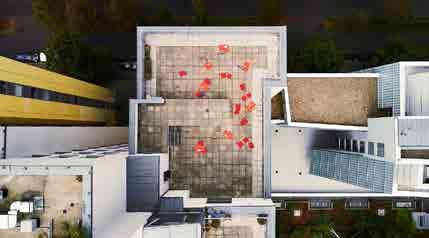
20 minute read
Fluchtbewegungen: Angst und Ankommen in Osteuropa / Routes of Escape: Fear and Arrival in Eastern Europe
Fluchtbewegungen: Angst und Ankommen in Osteuropa
Advertisement
Zwei Brandenburger Universitäten, zehn Studierende und 30 gesichtete Filme in einem Pilotprojekt: Diese Filmreihe ist das Ergebnis eines zweisemestrigen Filmkuratierungsseminars der Universität Potsdam und der Europa-Universität Viadrina Frankfurt Oder in Zusammenarbeit mit dem FilmFestival Cottbus. Nach intensiver Recherche zum Thema Migration im osteuropäischen Film präsentiert diese Specials-Reihe aktuelle Werke, die den Spagat zwischen Flucht, Angst und Reibung im Ankunftsland zeigen. Facettenreich setzen sich die ausgewählten Werke in kürzeren und längeren Geschichten mit individuellen, sprachlichen, soziokulturellen und bürokratischen Herausforderungen. Formal vollkommen unterschiedlich, zeichnen die Filme ein Bild beider Seiten. Hier die Probleme, Nöte und Hoffnungen der Geflüchteten, dort Hilflosigkeit, Phobien und Aggressionen der aufnehmenden Gesellschaft. Beide eint die Angst vor dem Unbekannten. Mit dieser Filmauswahl blicken die Zuschauer auf von Abwanderung bedrohte Landstriche und aussterbende Dörfer. Sie beobachten, wie menschliche Schicksale in bürokratische Schemata gepresst werden und erleben den Albtraum einer Flucht über das Mittelmeer. Zwischenmenschliche Beziehungen geben wiederum Anlass zur Hoffnung. Sie führen zum Umdenken und helfen dabei, Vorurteile im Ankunftsland abzubauen. Die Filme reflektieren das Ringen um Zugehörigkeit und Identität, sie befördern ein gesellschaftliches Miteinander. AJ & KR Two Brandenburg universities, ten students and thirty films in one pilot project: this series of films is the result of a two-semester film curating seminar run by the University of Potsdam and the European University Viadrina Frankfurt Oder in collaboration with the FilmFestival Cottbus. Having conducted intensive research on migration in East European film the makers behind this year’s Specials series present contemporary works that highlight the balancing act migrants are faced with when dealing with flight, fear and, not least, social friction in the country of arrival. These multi-faceted stories, both long and short, engage with the individual, linguistic, socio-cultural and bureaucratic challenges that migrants are exposed to. Though completely different in terms of form, these films depict both sides of the story. On the one hand the problems, needs and hopes of the refugees, on the other the helplessness, phobias and aggression of the host society. Both are united by a fear of the unknown. With this selection of films, we dive into exodus-threatened lands and villages, watch on as human fates are buried in bureaucratic procedures and experience the nightmare of flight across the Mediterranean Sea. All the while interpersonal relationships give hope and contribute towards a rethinking and the dismantling of prejudices in the country of arrival. The featured films contribute towards reflection on the struggle for belonging and identity, and thus contribute towards social cohesion. AJ & KR
Specials – Fluchtbewegungen: Angst und Ankommen in Osteuropa wird unterstützt von der Universität Potsdam, der Rosa-Luxemburg-Stiftung und der Hochschulrektorenkonferenz. Specials – Routes of Escape: Fear and Arrival in Eastern Europe is supported by the University of Potsdam, the Rosa-Luxemburg-Stiftung and the German Rector’s Conference.
CHILDREN OF SPRING FRÜHLINGSKINDER CHILDREN OF SPRING
DUŠAN SOLOMUN / DEUTSCHLAND / GERMANY, 2018, 42 MIN
Eine Schicksalsgemeinschaft – ein Boot voller aus Syrien geflüchteter Menschen: Männer, Frauen und Kinder – findet sich auf dem Dach eines Berliner Hochhauses ein, um die dramatischsten Momente ihrer Flucht noch einmal zu durchleben. Mit dabei: ein Schlauchboot, Rettungswesten, fehlendes Handysignal. Während sie stumm die Treppen erklimmen, macht ein altes Kinderlied Mut. A community of fate: a boat full of refugees from Syria, men, women and children, come together on the roof of a Berlin tower-block together with a life raft, life jackets and the absence of a mobile signal, in order to re-enact the most dramatic moments of their escape. As they silently climb the stairway, they draw courage from a well-known children‘s song.
Dušan Solomun
„Wir wussten nicht, dass aus unseren Geschichten eine Geschichte werden würde.“ Für die gut zwanzig Syrer wird das Häusermeer Berlins zur unheilvollen See zwischen der Türkei und Griechenland. Die Menschen, die ihre Fluchterfahrungen, ihre Ängste, Nöte und Hoffnungen miteinander teilen, kommen dem Publikum ganz nah. Wenn das Boot mit Wasser vollläuft, würde ich schwimmen? Was macht jemand, der nicht schwimmen kann, auf einem Schlauchboot im Mittelmeer? Selbstbewusst führt Ahmad Alkurdis den Betrachter durch den Film, das hier ist seine Geschichte. Regisseur Dušan Solomun verwebt das experimentelle Reenactment von Alkurdis Erzählung mit dessen Handy-Aufnahmen, mit poetischen Reflexionen über Identität, Würde und Menschlichkeit und mit einer Tonspur, die den Bildern einen noch tieferen Sinn verleiht, auch wenn nicht gesprochen wird. Entstanden ist ein faszinierender, emotionaler Film, der die individuellen Geschichten der Geflüchteten sichtbar werden lässt. RH “We didn‘t know that our individual fates would end up providing the material for a film.“ For these roughly twenty Syrians the sea of housetops in Berlin comes to represent the ominous waters between Turkey and Greece whilst the viewer comes to feel a close connection with these individuals, as they exchange their experiences of flight, as well as their fears, needs and hopes for the future. Would I be able to swim were the boat to spring a leak? What does he/she who is unable to swim do on a sinking life raft in the middle of the Mediterranean? In this self-assured work Ahmad Alkurdis guides the viewer through the film, this is his story. Director Dušan Solomun interweaves this experimental re-enactment of Alkurdi‘s story with the narrator‘s mobile phone footage, poetic reflections on identity, dignity and humanity as well as a soundtrack, the latter giving greater depth to the film‘s imagery, even during the moments when the protagonists remain silent. The result is a fascinating yet emotional film, which gives voice to the featured refugees‘ destinies. RH
Filmformat / Format DCP | doc. | Farbe / Colour Drehbuch / Script Dušan Solomun, Dellair Youssef, Ahmad Alkurdi Kamera / Photography Tilo Hauke Ton / Sound Oscar Stiebitz Schnitt / Editing Jan Bihl Musik / Music Emre Turkmeen Ausstattung / Set Design Jana Donis Darsteller / Cast Ahmad Alkurdi, Yazan Melhem, Dellair Youssef, Myriam Belhaj, Ahmed Roubied Produzent / Producer Dušan Solomun Produktion / Production Dušan Solomun Filmproduktion Co-Produktion / Co-Production Ohne Gepäck Filmproduktion Kontakt / Contact FILM FESTIVAL AGENCY Markus Kaatsch aug&ohr medien Riemannstr. 21 10961 Berlin, Germany +49 (0)30 61620068 film@augohr.de www.augohr.de
HIVATAL DAS BÜRO BUREAU
Stempel, wegheften, der Nächste bitte. Eine junge Sachbearbeiterin in der ungarischen Ausländerbehörde zwingt ihre Klienten durch ein engmaschiges Fragenraster zur Offenlegung intimer Angelegenheiten. Der Druck wächst auf beiden Seiten des Schreibtisches. Eine spröde Bürokratie-Kritik – nicht nur an ungarischen Verhältnissen. Stamp; file; next, please. A young case worker in the Hungarian foreigners’ registration office forces her clients to disclose intimate affairs by way of a finely tuned set of questions. The tension rises on both sides of the desk. A chilly criticism of bureaucracy – not only regarding conditions in Hungary.

Viktor Oszkár Nagy
Wir treten durch die Schwingtür der Ausländerbehörde ein in einen unbarmherzigen bürokratischen Apparat, in dem jeder Klient nur eine Akte ist. Der neuen Sachbearbeiterin Anna begegnen täglich verzweifelte Migranten zwischen Bleiberecht und Abschiebung. Viele von ihnen bangen auch nach Jahrzehnten in Ungarn noch um ihren Aufenthaltsstatus. Die Mischung aus persönlicher Nähe und dem Zwang, unpopuläre Entscheidungen zu treffen, wird Anna immer unangenehmer. Der Druck auf die junge Frau steigt, denn Empathie steht nicht in der Jobbeschreibung. Regisseur Viktor Oszkár Nagy, der sich bereits in seiner Dokumentation CAUGHT BETWEEN TWO WORLDS (2011) intensiv mit dem Thema Flucht und Migration beschäftigt hat, hinterfragt in DAS BÜRO nicht nur die ungarischen Verhältnisse, sondern auch gängige Klischees der Migrationspolitik. Der Fernsehfilm im dokumentarischen Stil zieht keine Grenze zwischen „Gut“ und „Böse“, sondern versucht, den kalten Mauern eines Amtes ein menschliches Gesicht zu geben: durch Protagonisten – Migranten, die ihre eigenen Fälle nachspielen – und Laienschauspieler, die in zumeist improvisierten Dialogen unmittelbar von der beklemmenden, verhör-ähnlichen Situation ergriffen werden. KG Passing through the foreigners’ registration office’s swinging door, we enter into a pitiless bureaucratic machine where each client is nothing more than a file. New case worker Anna daily meets desperate migrants caught between the right to stay and deportation. Many of them worry about their residence status even after decades of living in Hungary. This mixture of personal proximity and the constraint of having to make unpopular decisions makes Anna feel increasingly uncomfortable. The pressure the young woman is under mounts as empathy is not included in her job description. In BUREAU, Director Viktor Oszkár Nagy, who intensively explored the topic of escape and migration already in his documentary CAUGHT BETWEEN TWO WORLDS (2011), scrutinises not only the situation in Hungary, but also common migration policy clichés. This documentary style television film does not separate between ‘good’ and ‘evil’; rather, it attempts to furnish the cold walls of a government office with a human face – by way of protagonists (migrants re-enacting their own cases) and amateur actors who, in largely improvised dialogues, feel intuitively affected by the oppressive, interrogation-like situation. KG
Filmformat / Format HD File | Farbe/ colour Drehbuch / Script Viktor Oszkár Nagy, Petra Szőcs Kamera / Photography Tamás Dobos Ton / Sound Péter Benjámin Lukács Schnitt / Editing Péter Sass Musik / Music Csaba Hajnóczy Darsteller / Cast Anna Fignár, Zoltán Batka, Turan Kaya, Elif Kaya, Bernadett Valéria Marton-John, Sanju John Produzent / Producer Sára László, Marcell Gerő Produktion / Production Campfilm office@campfilm.eu Kontakt / Contact Campfilm LÁSZLÓ Sára sara@campfilm.eu +36202602606 Károly krt. 3/C. Budapest Hungary
HYVÄ POSTIMIES DER GUTE POSTBOTE THE GOOD POSTMAN
TONISLAV HRISTOV / FINNLAND, BULGARIEN / FINLAND, BULGARIA, 2016, 80 MIN
Ein abgelegenes, überaltertes Dorf wird Schauplatz der großen Politik. Es liegt in Bulgarien, an der Grenze zur Türkei, direkt an einer Fluchtroute. Ivan, der örtliche Briefträger, stellt sich zur Bürgermeisterwahl. Er möchte Geflüchtete in seinem Dorf ansiedeln und es dadurch wiederbeleben. Doch dagegen gibt es Widerstand. A remote, ageing village becomes the centre of international politics. It is located in Bulgaria, on the border with Turkey and right on an escape route. Ivan, the local postman, is standing for mayor. He wants to resettle refugees in his village and so bring life back into the community. But this is met with resistance.
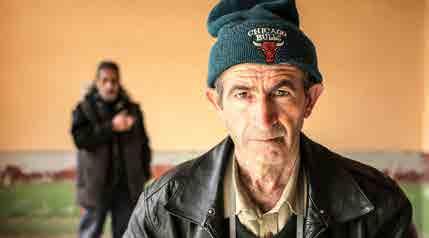
Tonislav Hristov
Ivans Gegner wollen entweder die Augen vor den Flüchtlingen verschließen, die Grenze dichtmachen oder den Kommunismus wieder einführen. Ivan hingegen macht Wahlkampf, während er Briefe austrägt, setzt sich mit seinen Nachbarn über das Für und Wider der Integration von Geflüchteten und damit der Zukunft des Dorfes auseinander. Der Dokumentarfilm teilt die Leidenschaft, den Humor und die Wärme seiner Protagonisten. Die postsozialistische Erfahrung und die Überalterung des ländlichen Raums werden verknüpft mit Diskussionen über die Zukunft der Dorfgemeinschaft. Abseits der großen Schauplätze der sogenannten „Flüchtlingskrise“ nimmt der Film nur vermeintlich eine periphere Perspektive ein – verhandelt er doch zentrale Fragen des Miteinanders. FS Ivan‘s opponents either want to close their eyes to the refugees, close the border or reintroduce communism. Ivan, on the other hand, is campaigning while delivering letters and arguing with his neighbours about the pros and cons of integrating refugees and thus the future of the village. The documentary shares the passion, humour and warmth of its protagonists. The post-socialist experience and the ageing of rural areas are linked to discussions about the future of the village community. Far from the areas dominated by the so-called “refugee crisis”, the film only appears to assume a peripheral perspective, since it is, in fact, addressing key questions about coexistence. FS
Filmformat / Format DCP | doc. | Farbe / Colour Drehbuch / Script Tonislav Hristov Kamera / Photography Orlin Ruevski Ton / Sound Momchil Bozhkov Schnitt / Editing Nikolai Hartmann Musik / Music Petar Doundakoff Produzent / Producer Kaarle Aho Produktion / Production Making Movies Oy kaarle.aho@mamo. fi Torkkelinkatu 3 Helsinki Finnland Co-Produktion / Co-Production Soul Food Kontakt / Contact CAT&Docs Maëlle Guenegues 18 rue Quincampoix Paris France maelle@catndocs.com +33144617748
LÉGMELL LUNGENKOLLAPS COLLAPSED LUNG
AMBRUS FATÉR / UNGARN / HUNGARY, 2017, 27 MIN
András ist ein erfolgreicher Arzt, aber einsam. Die Skype-Gespräche mit seiner im Ausland lebenden Tochter bleiben kühl. Sein Leben ändert sich, als er eines Tages um Hilfe gerufen wird. In der Moschee nebenan ist ein alter, illegal eingewanderter Flüchtling zusammengebrochen. Auch der ist einsam. András is a successful doctor, but lonely. The Skype calls with his daughter abroad remain distant. His life changes when one day he is called to help. In the mosque next door an old refugee who entered the country illegally has collapsed. He too is lonely.

Ambrus Fatér
Tag um Tag verstreicht im Gleichmaß der Routine in András Leben, bis der Hilferuf den symbolischen Stein ins Rollen bringt. Da der alte Mann, der kaum noch Luft bekommt, illegal eingewandert ist, kommt der Gang ins Krankenhaus nicht in Frage. András ringt mit sich: Er ist dem Fremden gegenüber distanziert, doch nach dem Selbstverständnis als Arzt muss er helfen. Widerwillig lässt er sich schließlich überreden, und die beiden verbindet etwas: Sie haben keine Familie. Der eine hat den Draht zu seinen Nächsten verloren, der andere wurde durch die Flucht von ihnen getrennt. So „verstehen“ sie sich trotz der Sprachbarriere. Dabei ist es vor allem András, der seine Gewohnheiten und Ansichten hinterfragt. Was ihm den Anstoß gibt, ein neues Kapitel in seinem Leben aufzuschlagen. Ambrus Fatér zeigt die charakterliche Wandlung eines Menschen, der durch eine unvorhergesehene Begegnung die emotionale Distanz zu seiner Umwelt genauso über Bord wirft wie seine Ressentiments gegen Geflüchtete. ES Day after day of András’s life passes in uniform routine until this call for help gets the symbolic ball rolling. As the old man, fighting for air, is an illegal immigrant, hospitalisation is out of the question. András battles with himself: he is dissociated from the stranger but being a physician he feels obliged to help. Reluctantly, he finally agrees, and the two men have something in common: they have no family. One has lost touch with his nearest and dearest and the other has been separated from them as a result of his escape. So, they ‘understand’ each other in spite of the language barrier. András begins to question his habits and views. This pushes him to turn over a new leaf in his life. Ambrus Fatér portrays a person’s change of character as an unexpected encounter prompts him to discard his emotional distance towards his environment as well as his resentment towards refugees. ES
Filmformat / Format DCP | Farbe / Colour Drehbuch / Script Dániel Daoud Kamera / Photography Dániel Kóródi Ton / Sound Márton Kristóf Schnitt / Editing Vanda Gorácz, Mariann Rudas Musik / Music Dávid Konsiczky Ausstattung / Set Design Anna Nyitrai Darsteller / Cast Lajos Ottó Horváth, Ahmed Fahran, Yaszin Il Karamany, Kata Wéber, Ferenc Fandi, Judit Bártfai Produzent / Producer Gábor Garami Produktion / Production University of Theatre and Film Arts in Budapest (SZFE) Co-Produktion / Co-Production Cinema-Film, Sunny Studio, Filmfabriq Kontakt / Contact Filmfabriq Veres Pálné u. 33. 1053 Budapest, HU +36 30 667 7613 info@filmfabriq.hu
OMAR VE BIZ OMAR UND WIR OMAR AND US
MARYNA ER GORBACH, MEHMET BAHADIR ER / TÜRKEI / TURKEY, 2019, 103 MIN
Die Geschwister Omar und Mariye sind mit dem Schlauchboot aus Syrien in die Türkei geflüchtet. Dort retten sie einen älteren Mann vor dem Ertrinken. Als Dank verhilft er ihnen zu einer Unterkunft bei seinem Nachbarn, einem pensionierten Kommandanten der Küstenwache. Der ist anfangs mehr als skeptisch, überwindet jedoch seine Feindseligkeit und will die beiden am Ende gar nicht mehr gehen lassen. Siblings Omar and Mariye flee Syria for Turkey in a rubber dinghy. In Turkey, they save an elderly man from drowning. Out of gratitude he organises accommodation for them with his neighbour, a retired coast guard commander. Rather sceptical at first, the commander overcomes his hostility and, in the end, does not want the two to leave.
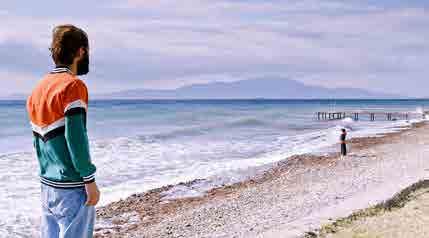
Maryna Er Gorbach, Mehmet Bahadir Er
Filme BLACK DOGS BARKING (2009, FFC 2009) LOVE ME (2013, FFC 2013)
Als der „Commander“ auf seinen verletzten Nachbarn Sabir und die zwei syrischen Geflüchteten trifft, will er sofort die Küstenwache alarmieren. Das Städtchen an der europäischen Außengrenze ist ein Transitort für illegale Einwanderer. Nur durch gutes Zureden seines Nachbarn lässt er widerwillig davon ab und nimmt sie bei sich auf. Seine Vorurteile aber bleiben. Erst mit dem Tod seiner Ehefrau verändert sich seine Einstellung. Der Kommandant fühlt sich plötzlich für Omar und Mariye verantwortlich, setzt sich sogar für ihren legalen Aufenthaltsstatus ein. Die beiden wollen jedoch nur eins: weiter über das Meer nach Europa. Die Villa des Kommandanten wird für sie letztendlich zum „goldenen Käfig“, aus dem sie versuchen auszubrechen. Maryna Er Gorbach und Mehmet Bahadir Er beleuchten in ihrem dritten gemeinsamen Spielfilm das schwierige Verhältnis von Einheimischen und Flüchtlingen zwischen Selbstbestimmung und Bevormundung und spielen dabei mit den Mitteln der Kolportage und der Soap Opera. SK Upon first meeting his injured neighbour Sabir and the two Syrian refugees, he is about to report them to the coast guard. The town on the European border is a transit point for illegal immigrants. He reluctantly abandons his initial intention only after his neighbour’s intensive persuasion and agrees to accommodate them. Yet his prejudices remain. His attitude doesn’t change until his wife’s death. Suddenly, the commander feels responsible for Omar and Mariye and even supports their legal residence status. However, the siblings desire only one thing: onwards across the sea to Europe. The commander’s villa ultimately becomes a ‘golden cage’ for them from which they try to break free. In their third joint feature film, Maryna Er Gorbach and Mehmet Bahadir Er explore the difficult relationship of natives and refugees between self-determination and patronisation and in doing so play with the devices of cheap sensationalism and soap opera. SK
Filmformat / Format DCP | Farbe / Colour Drehbuch / Script Mehmet Bahadir Er Kamera / Photography Aydin Sarioglu Schnitt / Editing Maryna Gorbach, Aziz Imamoglu Darsteller / Cast Cem Bender, Tajsher Yakub, Menderes Samancilar, Hala Alsayanah, Uygar Tamer, Ushna Çakir, Timur Ölkebaş, Ali Emrah Doğan Produzent / Producer Mehmet Bahadir Er Produktion / Production Protim V.P Co-Produktion / Co-Production kedr film Kontakt / Contact Mehmet Bahadir Er mehmetbahadire@gmail.com
SELITEV EIN NEUES ZUHAUSE A NEW HOME
ŽIGA VIRC / SLOWENIEN / SLOVENIA, 2016, 14 MIN
„All my dreams are coming ... “, klingt es aus dem Radio. Als mit der smarten Protagonistin in ein leeres, unfertiges Hochhaus auch die Paranoia vor den neu angekommenen Geflüchteten mit einzieht, ist es vor allem der Albtraum, der wahr wird. Psycho-Thriller über die Projektionen auf das Fremde. “All My Dreams Are Coming” is playing on the radio. The nightmare becomes reality when the elegant female protagonist‘s paranoia about the latest group of refugees pursues her into an empty, unfinished highrise building. Psychological thriller about the projections onto the unknown.
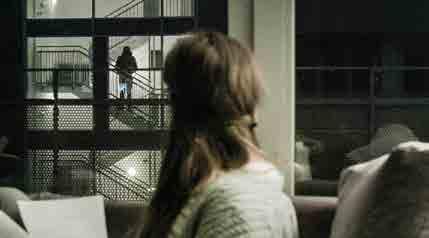
Žiga Virc
Filme HOUSTON, WE HAVE A PROBLEM! (2016, FFC 2016)
Panisch greift die 30-jährige Protagonistin nach dem Lichtschalter, als sie im leerstehenden Haus gegenüber die dunkle Silhouette eines Mannes erkennt. Sofort erinnert sie sich an das Flüchtlingszeltlager nicht weit entfernt von ihrer schicken Neubausiedlung. Hektisch rennt sie durch die Wohnung, verschließt die Wohnungstür, halluziniert, wie der Unbekannte sie umbringt. Alles nur ein Albtraum oder doch Realität? Gekonnt überspitzt fängt Regisseur Žiga Virc (HOUSTON, WIR HABEN EIN PROBLEM, FFC 2016) paranoide Bedrohungsängste vor den Fremden, nicht nur in der slowenischen Gesellschaft, ein. Eine faszinierend Bildsymmetrie und die suggestive Ich-Perspektive der Kameraführung machen EIN NEUES ZUHAUSE zu einem hochspannenden psychoanalytischen Thriller über das fragile, von Vorurteilen und Bedrohungsszenarien bestimmte Verhältnis von Mitteleuropäern zu Geflüchteten in der Hochphase der sogenannten „Flüchtlingskrise“. FK The 30-year-old female protagonist reaches in panic for the light switch when she sees the dark silhouette of a man in the empty house opposite. She immediately remembers that there is a refugee tent camp not far from her chic new housing estate. She frantically runs through the flat, locks the door, and hallucinates that the unknown man will kill her. Is everything just a nightmare or is it reality after all? Director Žiga Virc (HOUSTON, WE HAVE A PROBLEM!, FFC 2016) is adept at exaggeration in his portrayal of the paranoid fears of threat from strangers, something that is not only restricted to Slovenian society. A fascinating symmetry of images and the camera‘s suggestive first-person perspective make A NEW HOME a fascinating psychoanalytical thriller about the fragile relationship determined by prejudices and threat scenarios between Central Europeans and refugees at the height of the so-called “refugee crisis”. FK
Filmformat / Format DCP | Farbe / Colour Drehbuch / Script Žiga Virc, Boštjan Virc Kamera / Photography Darko Herič, ZFS Ton / Sound Matjaž Moraus Zdešar Schnitt / Editing Vladimir Gojun Musik / Music Matjaž Moraus Zdešar Ausstattung / Set Design Miha Ferkov Darsteller / Cast Nina Rakovec, Jernej Campelj Produzent / Producer Bostjan Virc Produktion / Production STUDIO VIRC; Boštjan Virc; Ilke Vaštetove 15, 8000 Novo mesto, Slovenia bostjan@studio virc.si info@studio virc.si +386 41 689 463 Kontakt / Contact Salaud Morisse Francois Morisset Schoenhauser Allee 8, 10119 Berlin, GERMANY festival@salaudmorisset.com + 49 1 52 25 19 23 3
ZÁHRADNÍC DIE GÄRTNER GARDENERS
MIRA FORNAY / SLOWAKEI, NIEDERLANDE / SLOVAKIA, NETHERLANDS, 2016, 22 MIN
Rassismus-Reflexion im Stummfilm-Format: Ein aus Tansania geflüchteter Junge versteckt sich auf einem Hof in der slowakischen Provinz und freundet sich mit der alten Bäuerin an, bis deren erwachsener Sohn zurückkehrt und ihn auf die Straße setzt. Reflection on racism in the silent film format: having fled Tanzania, a boy hides on a farm in the Slovak province and makes friends with the old farmer‘s wife until her adult son returns and throws him out onto the street.
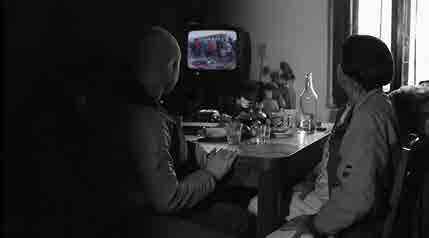
Mira Fornay
Filme MY DOG KILLER (2013, FFC 2013)
Die Begegnung zwischen dem Jungen und der Frau stellt sich als glückliche Fügung heraus. Beide brauchen auf ihre Art und Weise Unterstützung im Alltag. So helfen sie sich gegenseitig – eine Zweckgemeinschaft. Wie in einem Stummfilm nutzen die Protagonisten Hände und Füße als Mittel zur Verständigung und brechen dadurch sprachliche Barrieren. Nach anfänglichem Misstrauen bauen sie nach und nach eine fast familiäre Bindung zueinander auf, die brutal durch die Ankunft des Sohnes und dessen Fremdenfeindlichkeit zerstört wird. Die Regisseurin Mira Fornay war 2013 Mitglied der Internationalen Festivaljury beim FFC und landete mit ihrem mehrfach ausgezeichneten Film MY DOG KILLER einen Festivalhit. JK The encounter between the boy and the woman turns out to be a stroke of good fortune. Both of them need support in their own way in their daily life. And so they help one another – a partnership of convenience. As in a silent film, the protagonists use gestures and hand signs as a means of communication, thereby breaking down language barriers. After initial distrust, they gradually build up an almost family bond which is brutally destroyed with the arrival of their son and his xenophobia. Director Mira Fornay was a member of the FFC’s International Festival Jury in 2013 and landed a festival hit with her multiple award-winning film MY DOG KILLER. JK
Filmformat / Format DCP | Farbe / Colour Drehbuch / Script Mira Fornay Kamera / Photography Denisa Buranová Ton / Sound Richard Fülek Schnitt / Editing Mira Fornay Ausstattung / Set Design Eva Blahová Darsteller / Cast Hamisi Kikololo, Maria Fornayová Produzent / Producer Mira Fornay, Danielle Guirguis, Jaap Hermans Produktion / Production Mirafox s.r.o. Majakovskeho 19 90201 Pezinok Slovakia tel.: +421 904 881 384 mira.fornay@mirafox.sk Co-Produktion / Co-Production Smarthouse Films Kontakt / Contact International Film Festival Rotterdam Karel Doormanstraat 278-B 3012 GP, Rotterdam The Netherlands Gerben de Louw g.delouw@iffr.com +420 603 745519
Festival Del Cinema Europeo festivaldelcinemaeuropeo.com
Film Festival Cottbus filmfestivalcottbus.de
Scanorama Filmfestival – European Film Forum scanorama.lt








